David Suzuki's Blog, page 65
June 4, 2015
On World Oceans Day let's learn to treat the seas better
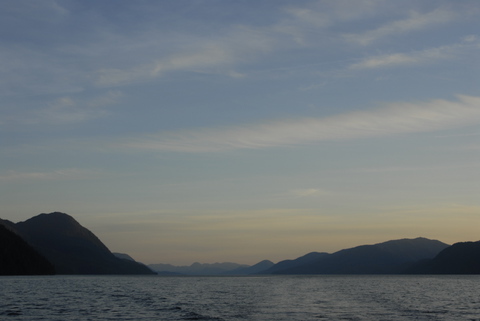
(Credit: Outer Shores Expeditions via Flickr)
June 8 is World Oceans Day. In Canada, it's a time to celebrate the rich marine life in three great oceans off the longest coastline of any nation -- trillions of plankton, billions of fish, millions of seabirds, thousands of whales and myriad other creatures great and small. Yet, we have little to celebrate when it comes to looking after this natural legacy. Although the federal government has committed to protect 10 per cent of our oceans by 2020, it has so far protected just one per cent.
Canada passed the Oceans Act 18 years ago, with a promise to safeguard our oceans and coastal ecosystems. It took another eight years to prioritize five large ocean management areas: the Beaufort Sea, the Gulf of St. Lawrence, the North Pacific Coast, the Eastern Scotian Shelf and Placentia Bay/Grand Banks. The process has languished and we're now 10 years behind schedule and contending with escalating demands for ocean uses, impacts from climate change and emerging issues such as ocean acidification and plastics pollution.
Marine planning, conservation and protection have never been more important. Energy development, shipping, fishing, conservation and ecotourism are bumping up against each other with no clear direction. This lack of coordination is like allowing a city to grow without zoning or planning, with schools built next to highways and industrial areas, residential neighbourhoods developed with no green spaces and first responders unable to get to those in need.
In the absence of federal leadership on marine planning and conservation, other levels of government have stepped in to take the lead -- just as they have with climate change commitments.
On B.C.'s Pacific North Coast, marine planning has moved ahead without the federal government, which dropped out of the planning process in 2011. Even without national representation, the results are encouraging. Eighteen coastal First Nations and the province of B.C. have come up with their own plans for coastal ecosystems.
Communities in this region have been defined by their relationship to the marine environment. With competing claims for ocean use and proposals to dramatically increase shipping traffic for oil and gas exports to Asia, these marine plans chart a course through challenging waters. Good public consultation and planning can help avoid expensive and disruptive conflicts that arise with so many interests competing for marine resources. These plans also provide meaningful engagement for industry and government with First Nations, a requirement highlighted in the Tsilhqot'in First Nations Supreme Court decision last June.
B.C.'s coastal communities are leading the way in our country's ocean planning. I'm happy to honour my relationship with 12 of those communities by embarking on a tour in June to talk about the many issues coastal communities are facing, including climate change. We can see its effects along the coast: shellfish die-offs, low snow packs affecting salmon runs, rising sea levels and altered growing seasons. These communities depend on healthy oceans for their cultural, social and economic needs and are searching for solutions. Ian Mauro, an award-winning community-based researcher and filmmaker who has also documented climate change in Atlantic Canada and from an Inuit perspective, is joining the tour with a new film that features climate change's impact on West Coast communities.
Oceans produce half the oxygen we breathe and absorb a third of carbon dioxide emissions. If that weren't reason enough to protect them, there's also a strong business case. According to a WWF report, oceans provide an annual economic value of at least $24 trillion. In Canada's Great Bear Sea, ecosystem services are estimated to provide $101 billion in annual benefits to local communities. Tourists pay to experience a clean, healthy ocean with an abundance of life, and marine recreation is projected to be among the fastest-growing sectors in B.C.'s economy for the next 20 years.
Marine wildlife and resources are rapidly declining around the world, and our oceans are changing faster than ever, endangering this economic engine and the security and livelihoods it supports. But our oceans are bigger and longer-lasting than any economic system. Canadians love their oceans and want their abundantly rich ecosystems to get the care they deserve. This World Oceans Day, let's honour our coastal waters and all the creatures that depend on them -- including ourselves.
Hey! Want more DSF? Join David Suzuki on Facebook

Day three: Coastal Connections Tour with David Suzuki

(Credit: Janice Williams)
By Panos Grames, Communications Specialist
It's truly impossible to predict how a day will unfold. Even one when you do everything you plan -- wake with your alarm, go to work in the usual way, hit all your scheduled appointments and meetings, go to sleep at the usual time -- because you can never foresee your conversations with people or your interactions with the world around you. And that's where things can get very, very interesting.
On our Coastal Connections Tour with David Suzuki, we have a tight schedule. We're going to 12 towns in 12 days, so just getting from venue to venue, setting up the halls, meals and accommodations must be organized to the last detail. Things have been anything but predictable.
We hit all our marks on day two, arriving in Port Alberni on Tuesday after a stop in Cathedral Grove to marvel at the ancient Douglas Fir trees in one of the few remaining patches of old growth forest on Vancouver Island. The Tseshaht First Nation welcomed us into their community and the townspeople attended in droves. Wednesday (day three) had two events: Comox at noon followed by Campbell River at 6 p.m.
We've listened to local First Nations Chiefs, city councillors and mayors. David Suzuki has given rousing speeches. But it's what we're hearing from the audience members -- shop owners, fishers, retirees, students, writers and people of every other occupation you could imagine -- that's most inspiring.

(Credit: Janice Williams)
People are telling us about their hopes for renewable energy development and their desire for participatory democracy. They're articulating their personal relationship to the natural world, and speaking about witnessing ecosystems change before their eyes and feeling profound loss.
Every room has been packed to capacity -- with bodies, yes, but also with incredible hope and a sense of relief that there are others out there who care and desperately want to make a difference.
Together, I think we can.
Today, we go to Alert Bay.
Hey! Want more DSF? Join David Suzuki on Facebook

Test your indoor air quality

Test your home (old or new) for mould and levels of carbon monoxide (CO), total volatile organic compounds (tVOCs), and formaldehyde (HCHO). (Credit: Brendon Purdy Photography)
I was beginning to worry about mould in my home -- airborne spores can be inhaled and become a health concern.
I wasn't feeling sick, but we discovered mould during a recent bathroom renovation, my husband had been rather sneezy and we have a child (children and the elderly can be more vulnerable).
Did you know mould comes in all colours -- not just black and white?
I called two companies to ask what was involved in a home indoor air quality test AND the cost. Within a day, a professional showed up to walk through my house with hand-held meters to test for levels of carbon monoxide (CO), total volatile organic compounds (tVOCs), and formaldehyde (HCHO). He also took an air sample and sent it for laboratory analysis to compare mould spore concentrations inside my home to concentrations outdoors.
The $500 I spent gave me peace of mind. My home does not have dangerous levels of mould that are allergenic, pathogenic or more serious toxigenic species. Everything else checked out safe, too! Note: get a few quotes.
I also asked about mould prevention. Guess what's likeliest culprit in my home (and probably yours)? Drying clothing indoors during winter (you know I like to save energy)!
Tip: If you dry clothing inside, run a fan. Luckily my bathroom fan is the next room over and it's Energy Star rated. Ventilation is key!
Mould prevention tips:
Run a fan (that's vented to the outside) when cooking or showering
Keep furniture away from exterior walls to allow air to circulate
Don't store goods in cardboard boxes (use mould-resistant options like plastic bins)
Don't store firewood inside the home
Own less stuff
See a full list from Health Canada.
If you're concerned about indoor air quality, contact a professional. You'll receive an air quality assessment report and prevention or mitigation suggestions.
How have you solved or prevented indoor air quality problems where you live?
Sincerely, Lindsay Coulter
A fellow Queen of Green
Hey! Want more DSF? Join David Suzuki on Facebook

June 3, 2015
Get radically Canadian with us!

Join thousands who have come forward. Angered by the federal government's disregard for the environment, thousands of people have come forward to declare themselves radically Canadian and join the David Suzuki Foundation as monthly donors.
Join thousands who have come forward. Angered by the federal government's disregard for the environment, thousands of people have come forward to declare themselves radically Canadian and join the David Suzuki Foundation as monthly donors.
Hey! Want more DSF? Join David Suzuki on Facebook

Get Radically Canadian with us!

Join thousands who have come forward. Angered by the federal government's disregard for the environment, thousands of people have come forward to declare themselves radically Canadian and join the David Suzuki Foundation as monthly donors.
Join thousands who have come forward. Angered by the federal government's disregard for the environment, thousands of people have come forward to declare themselves radically Canadian and join the David Suzuki Foundation as monthly donors.
Hey! Want more DSF? Join David Suzuki on Facebook
June 2, 2015
Day One: Coastal Connections Tour with David Suzuki Nanaimo, B.C. Reflections from the West Coast
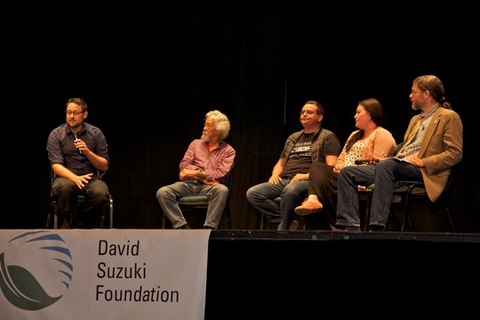
Credit: Janice Williams
The month of June is usually a time when British Columbians are looking forward to drier weather and sunshine brings us outdoors. This past month, however, was alarmingly dry. When we started our Coastal Connections Tour with David Suzuki in Nanaimo on June 1, the coastal city had just gone through the third driest May in over 100 years. It was an apt, yet disturbing, start to our 12-day tour of Vancouver Island and the central and north coasts of British Columbia to talk about oceans and climate change.
The sold-out event started with a welcome from Chief John Wesley of the Snuneymuxw First Nation who talked about the changes he's seen in the rivers over the past thirty years. He worries about how the next generation will learn to fillet and prepare fish if there are none to catch.
The Departure Bay Eco School followed with their "Trash to Treasure" display featuring materials from a beach clean-up transformed into an art and science display. The grade 5 and 6 students demonstrated how today's actions will impact their future.
The theatre darkened and the audience of 550 bore witness to the world premiere of Ian Mauro's 30-minute film on climate change and coastal people and ecosystems. Then it was the audience's turn to tell their stories and share ideas about how coastal communities can confront weighty topics such as climate change, ocean acidification and environmental degradation.
We heard about amazing relationships people had with nature, inspiring thoughts as well as expressions of despair and hope. Stay tuned for more reflections as the tour continues. Once the tour is finished, we will share what we hear with you, the communities we visit, and local, national and international decision-makers.
Hey! Want more DSF? Join David Suzuki on Facebook
May 28, 2015
Microbes, biodiversity and the benefits of getting dirty
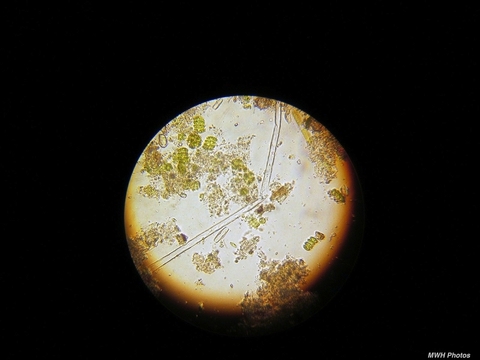
(Credit: merrymolly16 via Flickr)
We're surrounded by life, but Earth's most plentiful living things are invisible to the naked eye. Microbes are not only around us, they live on and in us. Although some cause maladies ranging from food poisoning to smallpox, there are many we couldn't live without.
Beneficial microbes break down food and produce vitamins in our guts. They coat our skin, protecting us from attacks by harmful microbes. Outside our bodies, they decompose organic waste, fix nitrogen and produce half the world's oxygen.
Scientists refer to the microbial communities on and in our bodies as "microbiomes". Every one of us hosts as many as 100 trillion microbes -- our guts alone are home to 500 to 1,000 different bacteria species!
Just as human activity is harming the diversity of visible life, it's also diminishing microbial diversity. As researchers learn more about the profound ways good microbes keep people healthy, they're also seeing how our urbanized, indoor lifestyles have transformed our microbiomes, increasing the risk of disease.
Just as we pollute the environment outside us, we can also pollute and upset the "normal flora" of our bodies by what we eat and do. Effects range from indigestion to deadly disease. One modern consequence of our lack of understanding about the necessity of healthy microbiomes is seen in our use of antibiotics. Despite their benefits, decades of overuse for personal sanitation, minor maladies and to promote growth in livestock has led to new illnesses and infections as sometimes-harmful bacteria evolve to resist antibiotics and our own microbial defences.
According to Alan Logan, author of Your Brain on Nature, diet and where we live and play have a tremendous influence on the microbial ecosystems on our skin and in our noses, mouths and intestines. Logan and experts from a range of disciplines at the Natural Environments Initiative workshop at Harvard School of Public Health found people who live in areas with rich plant diversity have more diverse microbiomes. The air we breathe, the soil we dig and the outdoor plants we come into contact with include a variety of microbes that may be absent in indoor and built environments.
Researchers have even found digging in dirt, whether gardening or playing, can benefit our physical and mental health. A microbe common to mud and wet soils, Mycobacterium vaccae, has been shown to influence brain neurotransmitters to reduce anxiety and improve cognitive functioning. Another microbe encountered in natural environments, Acinetobacter lwoffii, has been shown to benefit the human immune system, preventing asthma, hay fever and other ailments in children who have been exposed to it -- although it can also cause infections and gastric problems for people with compromised immune systems.
Research by Ilkka Hanski and colleagues at the University of Helsinki found microbe diversity reduced the incidence of allergies. They compared adolescents living in houses surrounded by biodiverse natural areas to those living in landscapes of lawns and concrete. From skin swabs, they learned that higher native-plant diversity appears to be associated with greater and more diverse microbial composition on the participants' skin, which led to lower risk of a range of allergies.
It's likely that, as we learn more about the microbial world, we'll find other beneficial microbes in nature. The research also highlights the importance of overall biodiversity to human health. A good solution to protecting biodiversity, from the smallest microbe to the largest animal, and to keeping ourselves healthy, is for all of us to spend more time outside.
According to the American Public Health Association, "People of all ages and abilities enjoy higher levels of health and well-being when they have nature nearby in parks, gardens, greenways, naturalized schoolyards and playgrounds, and natural landscaping around homes and workplaces."
People responding to David Suzuki Foundation surveys after our annual 30X30 Nature Challenge report significant mood improvements, more vitality and energy, and increases in nature-specific emotions like awe, curiosity and fascination. Research has also shown people who develop deeper connections with nature are more likely to care for and protect it, a phenomenon renowned biologist E.O. Wilson called "biophilia."
As this year's 30X30 Nature Challenge wraps up, consider it an inspiration to get outside every day of the year. It's good for your health, mood and microbiome -- and nature!
Hey! Want more DSF? Join David Suzuki on Facebook
Our corporate partners take the 30x30 Nature Challenge to work
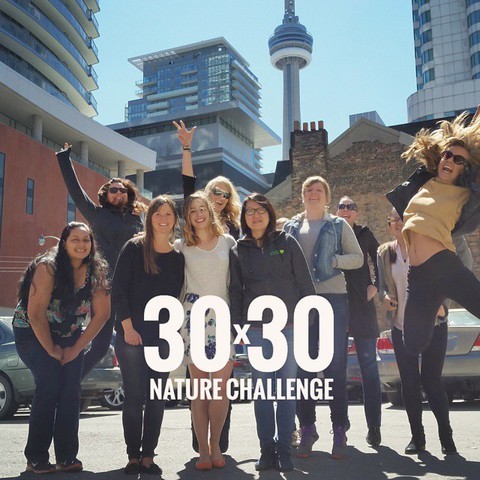
Genuine Health staff in Toronto celebrating the launch of 30×30 Nature Challenge 2015.
In the four years since it first launched, our 30×30 Nature Challenge has helped thousands of people across Canada and around the world spend more time outdoors. People get into "the nature habit" -- and they're happier and healthier as a result, as shown in research conducted by Elizabeth Nisbet of Trent University. Nurturing a connection to nature also makes people care about protecting it.
This wildly popular program would not have been possible without the generous support of our corporate partners, who helped fund the project AND made it come alive at their workplaces. Here's how they describe their 30×30 experience:
Genuine Health
" Genuine Health has proudly participated in the 30×30 Nature Challenge since its first year. This year, our staff once again embraced the Challenge with enthusiasm and loved the benefits of being outside. Even when we are busy, having this Challenge reminds us to take our meetings and breaks outside and admire the little moments, like taking in the cherry blossoms."
Interface
"Despite our innate affinity for nature, most of us -- especially those who live in cities -- spend too much of our time indoors. And given the scientific evidence that time spent in nature makes people feel happier by reducing stress and increasing energy levels -- what are we waiting for? At Interface, we're cultivating our nature habit and introducing the 30×30 Nature Challenge to our teammates and clients around the globe. We inspired customers in Bogota to host weekly outdoor luncheons every Friday through May. Our employees connect with nature by participating in walking meetings, outdoor lunch and learns and team meetings, and gardening."
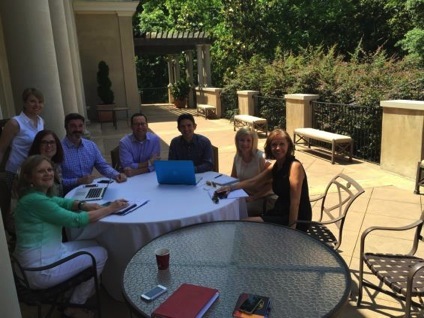
Interface America's marketing leadership team having a meeting outside.
Aimia
" Aimia is excited to be a corporate participant in the 30X30 Nature Challenge for the first time this year. Our offices across Canada are all in downtown locations, so our employees spend a good portion of their week indoors and commuting. To inspire some friendly competition, we invited staff to participate in a weekly photo challenge; pictures of workplace teams, outdoor hobbies and activities with friends and family were posted and shared on our internal blog. It was fantastic to see each other taking advantage of the great weather! We hope we've inspired new habits and regular green time."
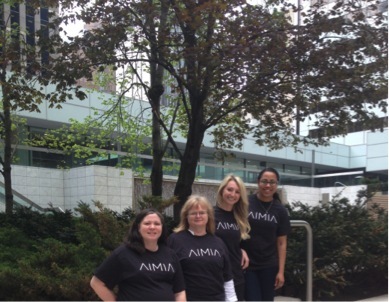
The Aimia team taking it outdoors!
Hey! Want more DSF? Join David Suzuki on Facebook
International neonicotinoid expert presents findings in Toronto
Evidence is clear: neonics cause grave harm, must be restricted
TORONTO, May 28, 2015 -- There is clear evidence that neonicotinoid pesticides harm a large number of non-target organisms including bees and other pollinators, according to a comprehensive review of more than 1,000 peer-reviewed reports conducted by the international Task Force on Systemic Pesticides. Jean-Marc Bonmatin, researcher at the French National Centre for Scientific Research (CNRS) and Task Force vice-chair, is in Toronto to share key findings as Ontario prepares regulations to restrict certain uses of neonics.
"As a scientist, I can now say conclusively that the evidence of harm is clear and points to the urgent need for action to reduce the quantities of these pesticides entering the environment," said Bonmatin.
The Task Force assessment of more than 1,000 studies published on the subject -- including those sponsored by industry -- is the most comprehensive review of the ecological effects of neonicotinoid pesticides undertaken to date. It was published in the journal Environmental Science and Pollution Research in January 2015.
"Ontario beekeepers continue to suffer the lethal effects of neonics on bees," said Dennis Edell, board member of the Ontario Beekeepers' Association. "Once again this planting season we have had multiple reports of bee kills."
Last year, Ontario beekeepers lost 58 per cent of their bees. Beekeeping is not sustainable when losses exceed 15 per cent.
"Pollinators play a vital role in food production," said Carolyn Young, director at Sustain Ontario. "Ontario should be a leader on this issue by protecting pollinators while supporting farmers."
Ontario has proposed North America's first regulatory restrictions on neonics, aiming to reduce the use of neonic-treated soybean and corn seeds by 80 per cent by 2017. Draft regulations were published for comment in March but have yet to be finalized.
"Ontario is on the right track with its plan to regulate an 80 percent reduction in the use of neonic seed treatments," said Lisa Gue, David Suzuki Foundation senior researcher and analyst. "The new regulations must be tight to ensure this target is met. Ultimately, we need to be working towards a global phase-out of these harmful chemicals."
A leaked report from Canada's federal pesticide regulator, the Pest Management Regulatory Agency, indicates that neonicotinoid seed treatments are of little value to Canadian agricultural production, despite their current widespread use.
Europe introduced a moratorium on neonics in 2013. Last year's corn crop yields reached record levels.
- 30 -
Contact:
Jode Roberts, David Suzuki Foundation: 647-456-9752; jroberts@davidsuzuki.org
Hey! Want more DSF? Join David Suzuki on Facebook
May 27, 2015
100,000+ signature petition to be presented in B.C. legislature today
Citizens, First Nations, conservation groups and business leaders call on premier to stop salmon farm expansion
Victoria -- More than 100,000 people have signed a petition calling on the B.C. government to halt federal government and B.C. salmon farming industry plans to expand open-net salmon farming in B.C. waters. The petition has received the endorsement of more than one hundred conservation organizations, industry associations, independent business owners and the Tofino‐Long Beach Chamber of Commerce.
MLA Andrew Weaver (Oak Bay-Gordon Head) will present the petition in the B.C. legislature today.
Despite decades of controversy and recommendations to the contrary from the $37-million Cohen Inquiry, the federal government wants to move ahead with industry expansion plans. However, the B.C. government has the power to curb that growth by withholding approvals for new farm sites and
The issue has gained renewed attention because of a recent federal court decision that raises concerns about disease impacts on wild fish from this industry and recent reports of outbreaks of sea lice on juvenile wild salmon now migrating past salmon farms on their way out to sea.
"Control of sea lice was the one issue I thought this industry could fix, but apparently not," said Alexandra Morton, who has been documenting sea lice outbreaks for 14 years. "Furthermore, the recent federal court ruling on use of diseased salmon in salmon farms has raised significant questions that need to be answered before this industry can even think of growing."
"Millions of wild juvenile salmon are now migrating through an area that contains the highest density of fish farms on our coast, from Campbell River to Port Hardy," said Karen Wristen, executive director of Living Oceans Society. "We are calling on Premier Clark to protect B.C.'s iconic wild salmon from federal recklessness and stop the planned expansion of this industry."
Since assuming responsibility for the management of salmon farming in 2010, Fisheries and Oceans Canada (DFO) says it has been working on revised criteria for siting farms. But they are far from completing that task and First Nations and conservation groups say they have been acting without the broad scientific and public consultation needed.
Meanwhile, they have permitted farms, like the one at Sir Edmund Bay (which is currently reporting elevated levels of lice levels), to triple their production.
Key information has also been unavailable from DFO. "We have asked DFO several times to share information on the current status of sea lice on fish farms in affected areas so that we can assess whether existing management strategies are working, but they have refused," said John Werring, David Suzuki Foundation senior science and policy advisor. "Their failure to respond on an issue of such immense public importance is simply unacceptable."
"Reams of published science already show that open net-pen salmon farming can depress wild salmon stocks, impede their growth and drive populations toward extinction," said Stan Proboszcz, Watershed Watch Salmon Society. "Premier Clark has the power to protect B.C.'s wild salmon from salmon farm expansion. More than 100,000 people are counting on her to do the right thing."
For further information, please contact:
Alexandra Morton, biologist
Pacific Coast Wild Salmon Society
(250) 974-7086
Karen Wristen, executive director
Living Oceans Society
(604) 788-5634
John Werring, science and policy advisor
David Suzuki Foundation
(604) 306-0517
Stan Proboszcz, fisheries biologist
Watershed Watch Salmon Society
(604) 314-2713
Salmon petition backgrounder
British Columbia's open-net salmon farming industry has a controversial history. In 2001, sea lice were observed infecting juvenile pink salmon in the Broughton Archipelago; the most likely source was the area's many open-net salmon farms. Numerous scientific studies have since been published; more industry problems revealed; and several high-profile investigations, inquiries and committees have concluded the industry is a threat to wild salmon and ocean habitat.
Risks to wild salmon
Sea lice from salmon farms are a significant threat to British Columbia's wild salmon. Stocked year round with hundreds of thousands of fish in tight quarters, salmon farms are ideal lice breeding grounds. Infestations on farms increase the number of lice in surrounding waters far beyond what would occur naturally. Each spring, juvenile wild salmon have to migrate near salmon farms on their way out to the open ocean. Sea lice from farms attach themselves to them. Their bodies may not be able to cope, and many die. Others experience reduced growth or succumb to predators. B.C. salmon farms are typically located in sheltered waters along wild salmon migration routes. In spring 2015, elevated levels of sea lice on juvenile salmon were once again reported by independent scientists in the Broughton Archipelago. The federal government doesn't monitor sea lice levels on wild salmon in all areas the industry operates, so the extent of damage is unknown.
Pathogens, such as bacteria and viruses from open-net salmon farms, were deemed an unacceptable risk by the $37-million Cohen Commission -- a federal inquiry examining the Fraser River sockeye decline. As with sea lice, open-net salmon farms are ideal environments for pathogen proliferation that may spread to wild salmon. The Cohen Commission opened the floodgates on pathogens and disease risks from salmon farms. Since then, independent testing of wild salmonids has produced positive results for viruses not previously found in British Columbia, linked to the farming industry. Some believe the industry may have transported viruses to B.C. waters via egg imports.
Legal precedents
The $37-million, taxpayer-funded Cohen Commission examined the issues facing declining Fraser sockeye salmon stocks and tabled its final report and recommendations in 2012. The Commission implicated open-net salmon farming industry as a "serious or irreversible" threat to wild sockeye salmon, primarily due to disease risks. It also concluded that "there is a risk that the Department of Fisheries and Oceans (DFO) will act in a manner that favours the interest of the salmon-farming industry over the health of wild fish stocks". Therefore, there is a potential conflict of interest within the federal Department of Fisheries and Oceans. The federal government has not acted on the Commission's third recommendation which states it "should remove from DFO's mandate the promotion of salmon farming as an industry and farmed salmon as a product." The federal support for open-net farming expansion is evidence.
On May 6, 2015, the Federal Court handed down a decision disallowing the salmon farming industry to make the decision to transfer diseased juvenile farmed salmon into net pens on wild salmon migration routes. The industry has four months to comply. The case revolved around the apparent high rate of piscine reovirus infection in farmed Atlantic salmon in British Columbia and around the world. The ruling was that portions of federal licences issued to each salmon farm would be struck down because they were in conflict with the Fisheries Act which prohibits transfer of diseased fish into the ocean. The Minister of Fisheries retains the right to permit transfer of diseased farmed salmon on a per case basis and it remains to be seen if she will appeal this decision. The full decision can be downloaded here.
Lack of transparency
New research by Alexandra Morton suggests that this year's wild salmon in the Broughton Archipelago are heavily infested with sea lice. This means one of two things: either effective sea lice management strategies are not being followed, or they are and the chemicals used to treat fish for sea lice, such as SLICE (emamectin benzoate), are not as effective as they once were.
To know for sure requires data. Since it took over management of the aquaculture industry in 2010, DFO has collected quarterly fish farm data on the prevalence of sea lice on farmed salmon as well as information about the amount of chemicals being used to treat for lice. By the time data is ready to be shared with conservation groups and members of the public, it can be as much as nine months out of date. And DFO does not share data gathered by fish farms even though farmed fish are hosts for sea lice, too. This data withholding is a troubling trend since DFO has taken over the management of fish farms.
Hey! Want more DSF? Join David Suzuki on Facebook
David Suzuki's Blog
- David Suzuki's profile
- 247 followers



